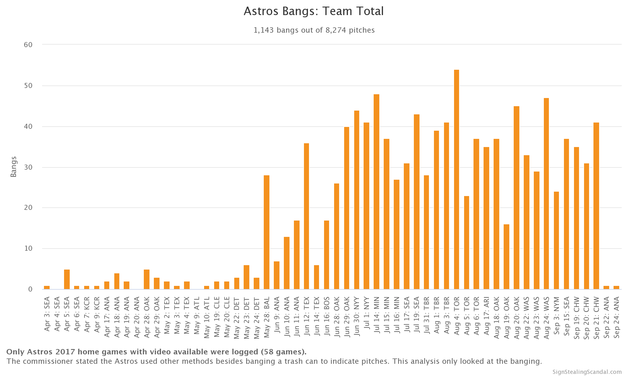The last four months have not been kind to the Houston Astros. The club lost Game 7 of the World Series in heartbreaking fashion in October, was outed as sign-stealing cheaters in November, lost Gerrit Cole to the postseason rival Yankees in December, and were hit with penalties stemming from the sign-stealing scandal in January. It's been a tough offseason. For sure.
As a public service, an intrepid Astros fan, Tony Adams, went back through the 2017 Astros regular season and logged every garbage can bang. Commissioner Rob Manfred's report confirmed the Astros banged a nearby garbage can to relay signs to the hitter after they'd been lifted from a live (and illegal) video feed that was piped to a monitor in the tunnel behind the dugout.
Adams' work, which is fascinating and appreciated, and was no doubt time consuming, logged over 1,100 bangs among more than 8,200 total pitches from the 58 Astros home games with available video in 2017. The data is available at SignStealingScandal.com. Here is Adams explaining his methodology:
I wrote an application that downloaded the pitch data from MLB's Statcast. This data has a timestamp for every pitch. I then downloaded the videos from YouTube and, using the timestamp, created a spectrogram for every pitch. A spectrogram is a visual representation of the spectrum of frequencies in an audio file. I could then playback the video of the pitches and, helped by the visual of the spectrogram, determine if there was any banging before the pitch.
I initially thought it would be quick work, and the application did make it pretty straightforward, but there are a lot of pitches in an MLB season. I ended up watching and logging over 8,200 pitches. And some more than once to be sure I was as accurate as possible.
Nearly every MLB game since 2009 is on YouTube in its entirety and I don't mean pirated. The games are available on the official MLB and MLB Classics channels. Adams went back and logged the garbage can bangs to determine and understand the scope of Houston's sign-stealing, at least with regards to what Manfred delightfully called the "banging scheme."
Here are four takeaways from Adams' work.
1. The timeline matches Manfred's
In the report detailing MLB's investigation, Manfred explained the Astros initially stole signs so the runner at second base could relay them to the hitter. It wasn't until a few months into the 2017 season that they moved on to banging garbage cans to expedite the process. From Manfred's report:
Approximately two months into the 2017 season, a group of players, including Carlos Beltrán, discussed that the team could improve on decoding opposing teams' signs and communicating the signs to the batter. (Alex) Cora arranged for a video room technician to install a monitor displaying the center field camera feed immediately outside of the Astros' dugout. (The center field camera was primarily used for player development purposes and was allowed under MLB rules at the time when used for that purpose.) Witnesses have provided largely consistent accounts of how the monitor was utilized. One or more players watched the live feed of the center field camera on the monitor, and after decoding the sign, a player would bang a nearby trash can with a bat to communicate the upcoming pitch type to the batter.
The data compiled by Adams confirms that timeline. Here is a graph from Adams' site showing the number of garbage can bangs per game throughout the season:

Late May, or "approximately two months into the 2017 season," as Manfred put it, is when the banging really started to pick up. That's what Manfred's investigation revealed and Adams' data confirms it.
2. Beltran was heavily involved
Carlos Beltran was the only player mentioned by name in Manfred's report. He and Cora were singled out as ringleaders. They helped put the system in place and suggested the team could get better at relaying signs. This paragraph from The Athletic's initial story into the sign-stealing suddenly makes more sense:
Early in the 2017 season, at least two uniformed Astros got together to start the process. One was a hitter who was struggling at the plate and had benefited from sign stealing with a previous team, according to club sources; another was a coach who wanted to help. They were said to strongly believe that some opposing teams were already up to no good.
With the Astros in 2017, Beltran managed a .627 OPS in April before putting up a .744 OPS in his next 70 games. Adams' research shows Beltran was at the plate for 138 garbage can bangs, third most on the team. There was a bang for 18.1 percent of his total pitches recorded. For reference, Beltran saw 40.4 percent offspeed pitches at home in 2017, and Manfred's report says "one or two bangs corresponded to certain offspeed pitches, while no bang corresponded to a fastball."
The data indicates Beltran had the signs for a little less than half the offspeed pitches he saw at home in 2017, though it was not spread out evenly. The banging scheme didn't really take effect until two months into the season, so Beltran had few signs early on and many signs later on. Also, Adams only recorded bangs that were audible on the broadcast, so the data may not be complete.
3. Some players had more signs than others
For whatever reason some Astros players received more signs via the banging scheme than others. Maybe the players who did not receive many signs felt it didn't help (or actively hurt) them at the plate, or believed it was unfair and chose not to participate. Either way, Adams' data shows some players received more signs than others.
Here are the three 2017 Astros regulars with the most bangs recorded while at the plate:
- Marwin Gonzalez: 147 bangs (18.9 percent of all pitches recorded)
- George Springer: 139 bangs (14.9 percent)
- Carlos Beltran: 138 bangs (18.1 percent)
Alex Bregman (133 bangs) and Yuli Gurriel (120 bangs) were the only other players with triple-digit bangs recorded, and their rates were higher than Springer's (16.6 percent and 17.9 percent, respectively). When you see the banging numbers, how different does Gonzalez's 2017 season look? Consider:
| PA | AVG/OBP/SLG | HR | BB% | K% | |
|---|---|---|---|---|---|
Gonzalez from 2015-16 | 888 | .264/.303/.418 | 25 | 4.3% | 21.6% |
Gonzalez in 2017 | 515 | .303/.377/.530 | 23 | 9.5% | 19.1% |
Gonzalez from 2018-19 | 1,015 | .255/.323/.411 | 31 | 8.3% | 22.1% |
Correlation does not equal causation, and Gonzalez was 28 in 2017, an age when many players have career years. Given what we know about the banging scheme now, it's awfully hard to give him or any Astros player the benefit of the doubt though. We know they were doing something illegal and unfair. The commissioner says so and the data says so.
Now here are the three 2017 Astros regulars with the fewest bangs recorded while at the plate:
- Jose Altuve: 24 bangs (2.8 percent of all pitches recorded)
- Josh Reddick: 28 bangs (3.9 percent)
- Brian McCann: 45 bangs (8.9 percent)
Adams' work makes it very clear that Astros players did not receive signs equally. Some received more -- many more -- than others for whatever reason. Altuve, the 2017 AL MVP, received only 24 signs via the banging scheme in the 58 games analyzed. We don't know why that is, but it is. Altuve, Reddick, and McCann did not partake as much as some of their teammates.
4. Aug. 4 was a bad day
The banging scheme peaked on Aug. 4, 2017. Adams recorded a season-high 54 bangs in a game the Astros won 16-7 over the Blue Jays that day. Houston broke the game open with a nine-run fourth inning. It was an extremely bad day for two Toronto pitchers in particular:
| IP | H | R | ER | BB | K | HR | |
|---|---|---|---|---|---|---|---|
Cesar Valdez | 3 1/3 | 6 | 6 | 6 | 2 | 1 | 1 |
Mike Bolsinger | 1/3 | 4 | 4 | 4 | 3 | 0 | 1 |
Valdez and Bolsinger never again pitched in the big leagues after that day. Valdez spent 2018 and 2019 pitching in the Mexican League and Bolsinger made his way to Japan after the season. Maybe the days were numbered on their MLB careers anyway, but could you really blame them if they feel the Astros robbed them of their livelihood? I couldn't.
Also, consider the situation. The Astros went into that Aug. 4 game with a 69-39 record and a 15-game lead in the AL West. The Blue Jays were 51-57 and in last place in the AL East. Against one of the league's worst teams and with a huge division lead, the Astros were still compelled to steal signs and get that unfair advantage. We will never know the full extent of the Astros cheating nor will we know how much it helped (or hurt), but it happened, and we now have more data on it than ever.


















